You can find relief from headaches with ten soothing herbal tea recipes that use natural ingredients. Try a chamomile and lavender blend for relaxation or peppermint and ginger tea to cool and calm. A lemon balm and honey mix offers gentle soothing, while rosemary and thyme can boost circulation. Turmeric and cinnamon help reduce inflammation, and valerian root combined with peppermint promotes calmness. Green tea with lemon zest is a revitalizing choice, while basil and clove tea enhances flavor for relief. Sage and honey bring comfort to the mix, and there's even more to discover about each recipe!
Chamomile and Lavender Blend
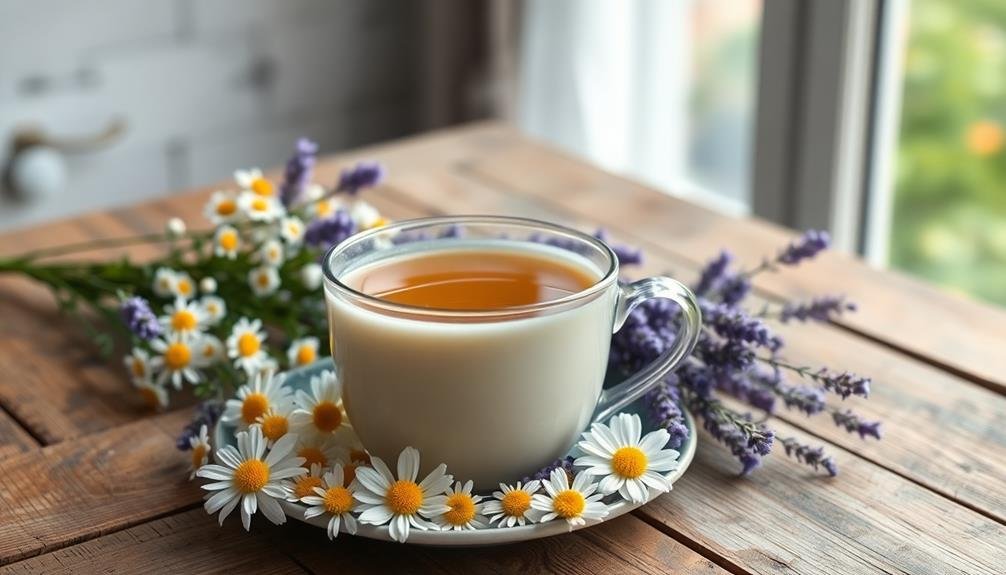
If you're looking for a soothing herbal remedy for headaches, the Chamomile and Lavender Blend is a fantastic option. This delightful combination not only smells amazing but also offers calming properties that can help ease your tension and discomfort.
Chamomile is known for its anti-inflammatory effects, which can reduce headache pain and promote relaxation. Lavender, on the other hand, has been praised for its ability to relieve stress and anxiety, making it an ideal partner for chamomile.
To make this blend, simply steep one teaspoon of dried chamomile flowers and one teaspoon of dried lavender buds in a cup of hot water for about 10 minutes. If you prefer, you can add a touch of honey for sweetness.
Sip this aromatic tea slowly, allowing the soothing warmth to envelop you. You'll likely find that the gentle properties of this herbal mix help you unwind and alleviate that pounding sensation.
Enjoy this tea in the evening after a long day or anytime you feel a headache creeping in. It's a natural, comforting solution that can become a go-to remedy in your wellness routine.
Peppermint and Ginger Tea
Peppermint tea is well-known for its invigorating flavor and ability to soothe headaches, thanks to its menthol content.
Ginger adds another layer of healing properties, making this combination a powerful ally against discomfort.
Let's explore how to brew this tea effectively to maximize its benefits.
Benefits of Peppermint Tea
When it comes to soothing headaches, peppermint tea stands out for its invigorating properties and therapeutic benefits. This delightful herbal tea not only tastes great but can also provide you with relief when you need it most. The menthol in peppermint acts as a natural muscle relaxant, helping to ease tension headaches.
Here are three benefits of enjoying peppermint tea:
- Cooling Sensation: The cooling effect of menthol can alleviate pain and discomfort, making it a perfect choice for headache relief.
- Improved Circulation: Drinking peppermint tea may help improve blood circulation, which could reduce the intensity of headache symptoms.
- Stress Relief: The aroma of peppermint is known to promote relaxation, helping to reduce stress levels that often contribute to headaches.
Incorporating peppermint tea into your routine can be an effective strategy for headache management.
Whether you sip it hot or iced, the revitalizing flavor can uplift your mood while providing the relief you seek.
Ginger's Healing Properties
While you might already appreciate the soothing effects of peppermint tea, combining it with ginger can elevate your headache relief even further. Ginger has been used for centuries to ease various ailments, including headaches. It contains powerful anti-inflammatory properties that can help reduce pain and tension.
When you brew ginger with peppermint, you create a potent blend that not only tastes great but also targets headache symptoms effectively. Ginger's active compound, gingerol, helps improve blood circulation and can alleviate nausea, which often accompanies headaches.
This combination of ingredients works synergistically to provide a warming effect, helping to relax your muscles and calm your mind. You'll find that the zesty flavor of ginger beautifully complements the invigorating notes of peppermint, making each sip a delightful experience.
Moreover, ginger can help reduce stress, one of the common triggers for headaches. By integrating this warming root into your tea routine, you're equipping yourself with a natural remedy that promotes overall wellness.
The next time you feel a headache creeping in, consider reaching for peppermint and ginger tea – it might just be the soothing solution you need.
Brewing Tips and Techniques
For an ideal brewing experience, start with fresh ingredients to release the full potential of peppermint and ginger tea. Using fresh herbs guarantees that you'll get the most vibrant flavors and health benefits.
Here's how to brew a perfect cup:
- Choose your ingredients wisely: Use fresh peppermint leaves and a small piece of ginger root. If you can't find fresh, dried options work too, but they may lack some potency.
- Prep your ginger: Peel and slice about one inch of ginger. The thinner the slices, the more flavor will infuse into the tea. You can also grate it for an even stronger taste.
- Brewing process: Boil 2 cups of water and add your ginger first, letting it simmer for about 5-10 minutes.
Then, add the fresh peppermint leaves and steep for an additional 5 minutes. Strain and enjoy your tea hot, or let it cool for a revitalizing iced version.
Following these tips will help you create a soothing, aromatic cup of peppermint and ginger tea, perfect for alleviating headaches and promoting relaxation. Enjoy!
Lemon Balm and Honey Mix
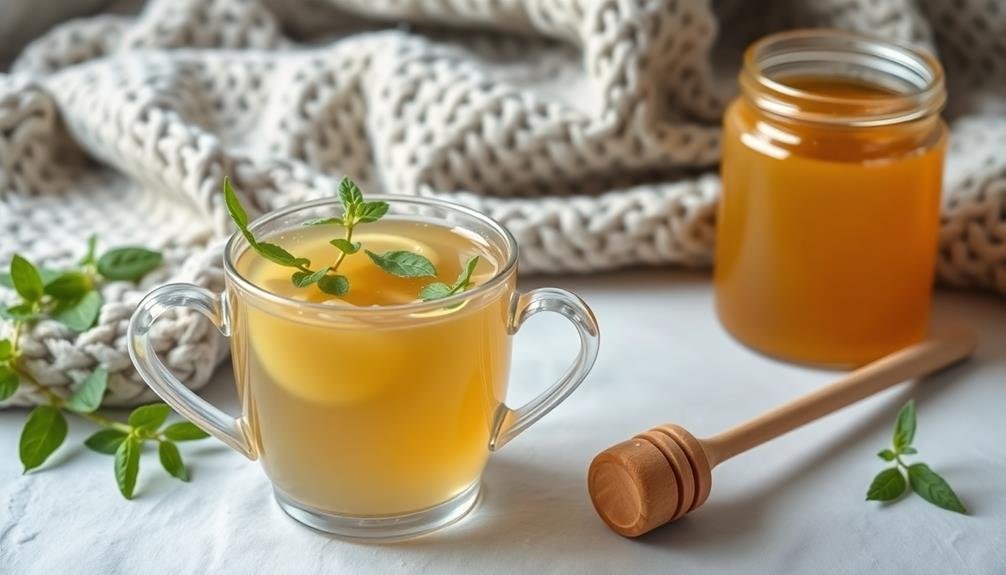
Lemon balm, with its soothing properties, pairs wonderfully with honey to create a comforting tea that can help alleviate headaches. This delightful blend not only tastes great but also offers calming effects that may ease tension and stress, common triggers for headaches.
To prepare this herbal tea, simply steep fresh or dried lemon balm leaves in hot water for about 5 to 10 minutes. Then, stir in a spoonful of honey to sweeten the flavor and enhance the tea's soothing qualities. You'll find that the combination of lemon balm's gentle aroma and honey's natural sweetness creates a relaxing experience.
Here's a quick comparison of the benefits of lemon balm and honey:
| Ingredient | Benefits |
|---|---|
| Lemon Balm | Reduces anxiety, promotes sleep |
| Honey | Antioxidant properties, soothing |
| Helps with throat irritation | |
| Natural energy booster |
Enjoy this warm beverage whenever you feel a headache coming on, or simply as a part of your daily relaxation routine. You'll likely find it's a wonderful way to unwind and refresh!
Rosemary and Thyme Infusion
If you're looking for a natural remedy, consider a rosemary and thyme infusion.
Rosemary is known for its health benefits, including boosting circulation and reducing inflammation, while thyme brings calming properties that can help ease tension.
Together, they make a powerful combination to help relieve headaches.
[DIRECTIONS]:
Health Benefits of Rosemary
When you're looking to ease a headache, consider steeping a rosemary and thyme infusion. Rosemary is more than just a flavorful herb; it's packed with health benefits that can help alleviate your discomfort. Known for its anti-inflammatory properties, rosemary can reduce tension and improve circulation, promoting overall relaxation.
Here are three key benefits of rosemary that can support your headache relief:
- Antioxidant Power: Rosemary contains potent antioxidants that combat oxidative stress, potentially reducing headache triggers linked to inflammation.
- Aromatherapy Benefits: The scent of rosemary can help clear your mind and enhance focus. Inhaling its aroma may also reduce stress and anxiety, which are common headache culprits.
- Digestive Aid: Sometimes headaches arise from digestive issues. Rosemary can aid digestion, which may help alleviate headaches related to stomach discomfort.
To prepare your infusion, simply steep fresh or dried rosemary and thyme in hot water for about 10 minutes. Strain and enjoy the soothing warmth.
Incorporating this herbal blend into your routine could be a delicious way to find relief from those pesky headaches.
Thyme's Calming Properties
Thyme complements rosemary's benefits beautifully, especially when it comes to calming your mind and body. This herb is well-known for its soothing properties, making it an excellent addition to your herbal tea repertoire.
When you're feeling stressed or overwhelmed, a simple infusion of rosemary and thyme can help ease those tension headaches that often accompany mental strain.
Thyme contains thymol, a compound that not only promotes relaxation but also supports your respiratory system. This can be particularly helpful if anxiety is contributing to your discomfort.
The warm, earthy flavor of thyme paired with rosemary's aromatic qualities creates a tea that's both delightful and therapeutic.
To make this infusion, steep a teaspoon of dried thyme and a teaspoon of dried rosemary in hot water for about five to ten minutes. Strain the herbs and enjoy your calming cup.
If you want to enhance the flavor, consider adding a touch of honey or a slice of lemon.
Incorporating thyme into your routine can provide consistent stress relief, helping you to unwind after a long day.
Turmeric and Cinnamon Brew

A turmeric and cinnamon brew can be a soothing remedy for headache relief. Both turmeric and cinnamon possess anti-inflammatory properties that may help reduce pain and discomfort.
When combined in a warm brew, they create a comforting drink that not only tastes great but can also provide a sense of relaxation.
To enjoy this brew, follow these simple steps:
- Ingredients: Gather 1 teaspoon of turmeric powder, 1 teaspoon of ground cinnamon, and 2 cups of water. You might also want to add honey or lemon for extra flavor.
- Preparation: In a small saucepan, bring the water to a boil. Add the turmeric and cinnamon, stirring well to combine. Lower the heat and let it simmer for about 10 minutes.
- Strain and Serve: Remove from heat and strain the brew into your favorite mug. Add honey or lemon if desired, and enjoy your soothing drink while relaxing in a quiet space.
This turmeric and cinnamon brew can be a delightful addition to your routine, offering both flavor and headache relief when you need it most.
Hibiscus and Fennel Combination
For those seeking an invigorating twist on headache relief, the hibiscus and fennel combination offers both flavor and therapeutic benefits. Hibiscus is known for its tart, revitalizing taste, while fennel adds a sweet, anise-like note that complements the blend beautifully. Together, they create a delightful herbal tea that not only pleases your palate but also aids in alleviating headaches.
To prepare this soothing tea, start by steeping a tablespoon of dried hibiscus flowers and a teaspoon of crushed fennel seeds in boiling water for about 10-15 minutes. This allows the flavors to meld while extracting the beneficial properties of both herbs.
Strain the mixture into your favorite cup and sweeten it with honey or a splash of lemon if you prefer.
Hibiscus is rich in antioxidants, which can help reduce inflammation, while fennel is known for its ability to ease digestive issues that might contribute to your discomfort. Enjoy this vibrant tea hot or cold; it's versatile enough to suit any occasion.
With each sip, you'll not only quench your thirst but also nurture your body, making it a great choice for natural headache relief.
Valerian Root and Peppermint
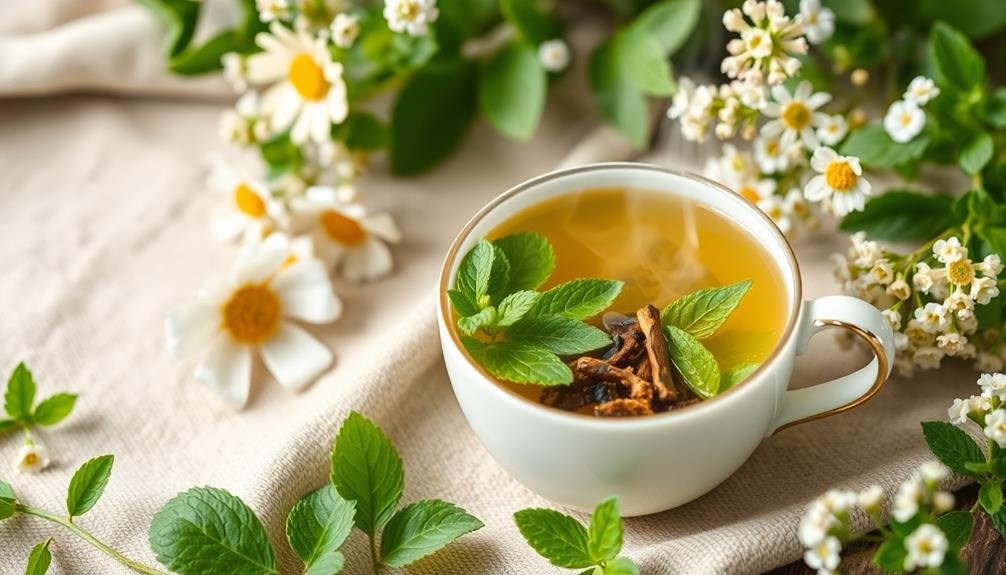
Two powerful herbs, valerian root and peppermint, come together to create a calming tea that can help alleviate headaches.
Valerian root is known for its sedative properties, making it an excellent choice for promoting relaxation and easing tension. Peppermint, on the other hand, has soothing effects that can relieve headaches by increasing blood flow and reducing muscle spasms.
Together, they create a delightful blend that not only tastes good but also works wonders for your head.
To enjoy this soothing tea, follow these simple steps:
- Ingredients: Gather 1 teaspoon of dried valerian root and 1 teaspoon of dried peppermint leaves. Use fresh herbs if available for a more vibrant flavor.
- Brewing: Boil 2 cups of water, then steep the herbs for about 10-15 minutes. Cover the teapot to keep the essential oils from escaping.
- Serving: Strain the tea into your favorite mug. You can sweeten it with honey or add a splash of lemon for extra flavor if desired.
Sip slowly and let the calming effects wash over you, providing much-needed relief from headaches.
Green Tea With Lemon Zest
After enjoying the calming effects of valerian root and peppermint, you might want to explore another stimulating option for headache relief: green tea with lemon zest. This revitalizing blend not only offers a delightful taste but also packs a punch when it comes to soothing headaches. Green tea is rich in antioxidants, which help combat inflammation, while lemon zest adds a zesty kick and a boost of vitamin C.
To prepare this tea, simply steep a green tea bag in hot water for about three minutes. Then, add a teaspoon of freshly grated lemon zest. Let it steep for an additional minute before enjoying.
Here's a quick summary of the benefits:
| Ingredient | Benefits |
|---|---|
| Green Tea | Reduces inflammation |
| Lemon Zest | Boosts vitamin C intake |
| Combined Effects | Enhances overall wellness |
Sipping on green tea with lemon zest can uplift your spirits and help alleviate your headache. So, the next time you feel a headache creeping in, give this stimulating tea a try!
Basil and Clove Tea
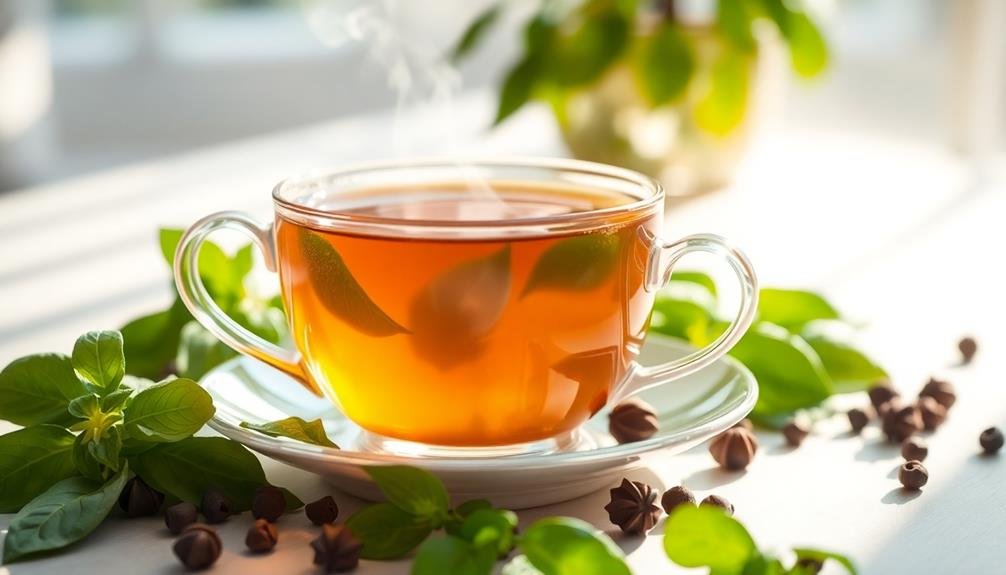
Basil and clove tea offers a unique blend of flavors that not only delights your taste buds but also provides powerful headache relief. The combination of basil's soothing properties and clove's anti-inflammatory effects can help alleviate the discomfort of headaches.
When you sip on this aromatic tea, you're not just enjoying a tasty beverage; you're also nurturing your body.
To make the most of your basil and clove tea experience, follow these simple steps:
- Gather Ingredients: You'll need fresh basil leaves, whole cloves, water, and optional honey or lemon for sweetness.
- Brew the Tea: Heat water and add a handful of basil leaves along with 2-3 whole cloves. Let it steep for about 10 minutes to extract the full flavors and benefits.
- Strain and Enjoy: Strain the tea into your favorite cup. If you like, add a teaspoon of honey or a splash of lemon juice for added flavor and health benefits.
Enjoy this warm, comforting tea whenever you feel a headache coming on, and let its natural properties work their magic!
Sage and Honey Elixir
How can a simple blend of sage and honey provide soothing relief for your headaches? This elixir combines the anti-inflammatory properties of sage with the natural sweetness and soothing characteristics of honey, creating a delightful remedy.
Sage, known for its calming effects, can help ease tension and reduce headache symptoms.
To make your Sage and Honey Elixir, you'll need a teaspoon of dried sage leaves, one cup of hot water, and a tablespoon of honey.
Start by steeping the sage leaves in hot water for about five to ten minutes. This allows the beneficial compounds to infuse into the water.
After steeping, strain the mixture into your favorite mug, and stir in the honey until it dissolves.
Enjoy this elixir while it's warm; the aromatic sage will help clear your mind, while the honey adds a touch of comfort.
Sip slowly, letting the warmth wash over you, and feel the tension melt away.
While the Sage and Honey Elixir isn't a cure-all, it's a soothing option that can provide comfort during those throbbing moments.
Frequently Asked Questions
Can Herbal Teas Interact With Prescription Medications?
Yes, herbal teas can interact with prescription medications. It's essential to consult your healthcare provider before adding them to your routine, as some ingredients may amplify or diminish the effects of your medications. Stay informed!
How Often Can I Drink These Herbal Teas?
You can drink herbal teas daily, but moderation's key. Start with one to two cups, then adjust based on how your body responds. Always listen to your body and consult your doctor if unsure.
Are There Any Side Effects From These Herbal Ingredients?
Certain herbal ingredients can cause side effects like allergies, digestive issues, or interactions with medications. It is crucial to consult a healthcare professional before using them, especially if you have existing health conditions or take other medications.
Can I Use Fresh Herbs Instead of Dried Ones?
Yes, you can use fresh herbs instead of dried ones. Fresh herbs often provide a more vibrant flavor and aroma, but you'll need to adjust the quantity, as they're generally less concentrated than their dried counterparts.
How Should I Store Leftover Herbal Tea?
To store leftover herbal tea, pour it into an airtight container and refrigerate. It'll stay fresh for up to three days. When ready to enjoy, just reheat or drink it cold.
In Summary
With these 10 soothing herbal tea recipes, you've got plenty of options to find relief from headaches naturally. Whether you prefer the calming notes of chamomile or the revitalizing zing of peppermint, there's a blend for everyone. Experiment with the ingredients and discover what works best for you. So, when that headache strikes, grab your favorite herbs, brew a cup, and sip your way to comfort and relaxation. Enjoy the process and the soothing benefits!

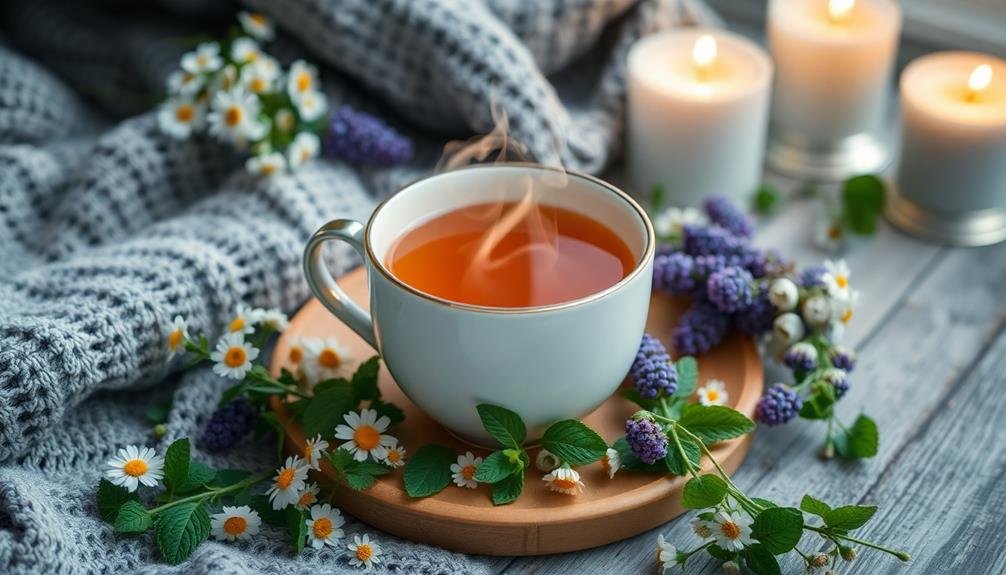
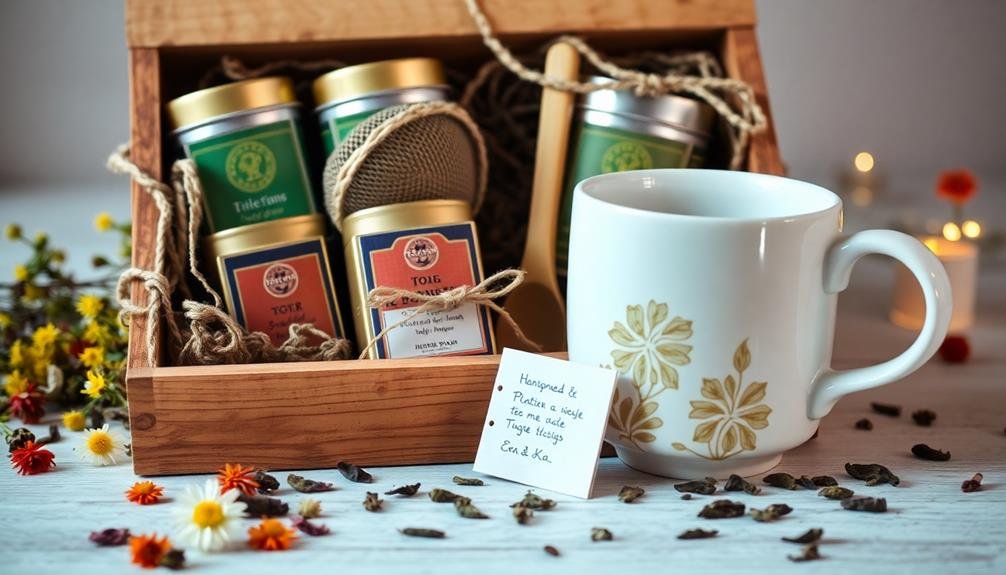
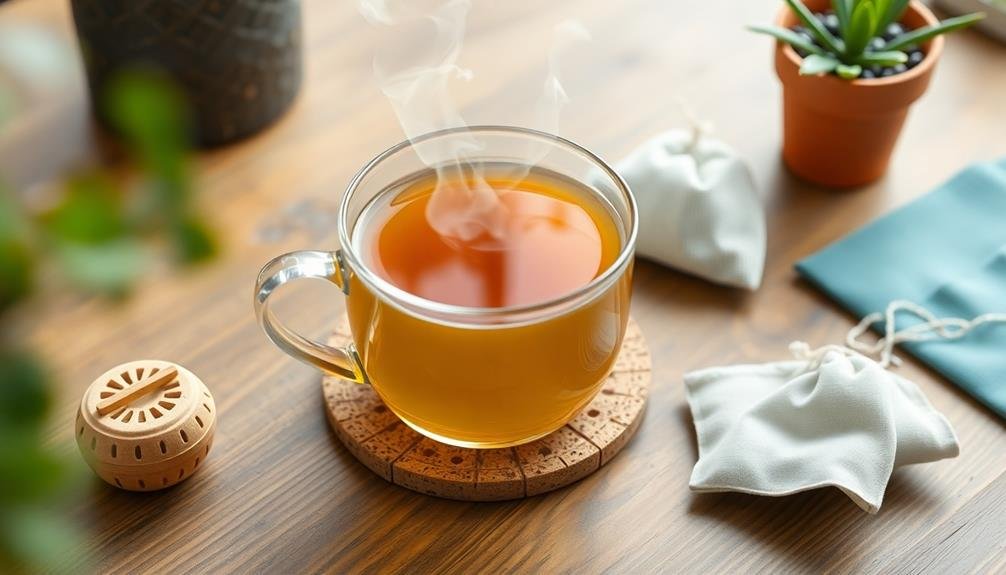

Leave a Reply